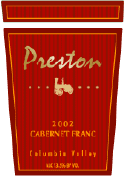
With that in mind, I’ve been wanting to try some of the wines from Twisted Oak Winery and winemaker Jeff Stai. Many of us in the wine blogosphere have gotten to know a little about Twisted Oak and Jeff (El Jefe) through the winery’s blog, El Bloggo Torcido, and Jeff’s frequent comments on other blogs.
Unfortunately, Twisted Oak wines have not found there way to my part of the world. However, the Gods of Good Fortune smiled upon me, and I recently received a box with two bottles of Twisted Oak 2003 California Murgatroyd and, of course, a rubber chicken.
When they are not involved in rubber chicken distribution, Twisted Oak produces an eclectic line-up of wines from varietals such as verdelho, albariño, temperanillo, grenache, syrah and petite sirah.
With a blog called El Bloggo Torcido, a wine called the Spaniard and a collection of typical Spanish grapes, it doesn’t take a rocket scientist to determine that Twisted Oak has a decidedly Spanish flair.
Which brings me back to the Murgatroyd, this wine is a blend of 36% cabernet sauvignon, 31% tempranillo, 19% petite sirah and 14% grenache. This wine grabbed my attention partly because the interesting blend of grapes. It reminds me of some of the wines coming out of the Priorat region of Spain, which usually incorporate cabernet sauvignon and grenache, along with some other grapes.
On a side note, any wine named after the catch-phrase of a cartoon character from my youth automatically gets a few extra points in my book.
The Murgatroyd is a deep purple with lush aromas of blueberry, cinnamon and a touch of vanilla. The flavors are soft and round with blueberry,raspberry, mint, vanilla and just a hint of oak. I decanted it for 30 minutes of so before drinking, and it continued to open up nicely while we sipped it over dinner.
My intuition about the blend was dead-on—this wine is very reminiscent of a young Priorat. I’m also willing to bet it will gain even more complexity with a little more bottle age.
Most of the grapes for the Murgatroyd come from the Vallecito and Tanner Vineyards in Calaveras County, the remainder come from the Bokisch and Silvaspoon Ranches in the Central Valley. Because not enough of the grapes come from the same region, the Murgatroyd is labeled simply as California wine.
I wondered if this is akin to really good French wine that ends up being labeled as Vin de Pays (which several of my favorite French wines are). So, I put the following questions to Jeff via e-mail:
Me: Since you know the source of the grapes, why is it labeled as a California wine?
El Jefe: Two of the vineyards are in Calaveras, and two of the vineyards are in Lodi. Since Lodi is not in the Sierra Foothills, we had to go with California. To call it Calaveras we would have to have a higher percentage of Calaveras fruit in it.
Me: What are your thoughts about labeling a high-quality wine with the California designation?
El Jefe: I don't think there is anything deeply wrong with it (I think it is a nice state), but I would prefer not to. It helps that we are up front with the blend and vineyards, and that the wine is popular and it tastes good. Future vintages will be "Calaveras County" AVA!
I always wondered if having to use the California designation on more expensive wines was a bit of a “black-eye.” It certainly doesn’t bother me, but I’m sure some wine buyers associate the California designation with cheap, mass-produced wines.
In any case, Twisted Oak Winery is a great example of what I hope will be the next wave of California wineries: wineries that produce interesting and different wines from grape varieties they are passionate about and not just the “grape du jour.”
Another bit of related good news—Jeff informs me that hopefully I’ll be able to buy Twisted Oak wines down here in the South before to long.










